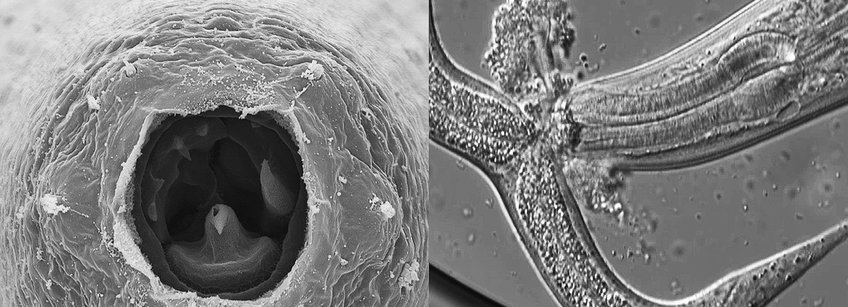
Integrative Evolutionary Biology - Ralf J. Sommer
We take an integrative approach and try to link evo-devo with population genetics and evolutionary ecology by studying the nematode Pristionchus pacifius, which lives in a defined scarab beetle ecosystem.
How do developmental processes change during evolution? We take an integrative approach and try to link evo-devo with population genetics and evolutionary ecology by studying the nematode Pristionchus pacifius, which lives in a defined scarab beetle ecosystem.
We link development, ecology, and population genetics in a highly integrative approach to study how novel and complex traits evolve as a result of historical processes. We focus on developmental (phenotypic) plasticity as a facilitator for the evolution of novelty, complex traits, and phenotypic divergence. Despite the modern synthesis neglect of developmental plasticity and lack of sufficient insight into the evolution of novel structures, a theoretical framework has been built in the last two decades that highlights plasticity as a key concept in evolutionary biology (West-Eberhard 2003, Sommer 2020).
The Role of Plasticity in Evolution
However, a complete appreciation of plasticity and its role in evolution requires the identification of associated molecular mechanisms; in the last decade, my laboratory has arguably provided the most detailed molecular understanding of any plastic trait. First, we identified developmental switches that can sense the environment and reprogram development, thereby confirming long-standing theoretical predictions. Second, we have determined the downstream gene regulatory network (GRN) that guides phenotypic execution of alternative phenotypes. These findings, for the first time, demonstrate that plasticity is indeed consistent with the modern synthesis. More importantly, they provide a molecular framework to elucidate the mechanisms of plasticity-associated evolution from the i) origin of plasticity, through ii) genetic accommodation, to iii) final assimilation (canalization). These three steps will be the foundation of our research in the coming decade.
The Model System Pristionchus pacificus
Using the free-living nematode Pristionchus pacificus as a model system, we combine laboratory studies of plasticity (forward and reverse genetics, genomics, transgenesis, experimental evolution) with field work (ecology and natural variation). In addition, we couple our model system approach with macro-evolutionary comparisons, utilizing more than 1,500 strains of P. pacificus and around 50 culturable Pristionchus species that have been collected globally (www.pristionchus.org). Our established field station on La Réunion, an island in the Indian Ocean that harbors the complete worldwide genetic diversity of P. pacificus, serves as a microcosm to investigate developmental plasticity and its role in the environment and the nematode ecosystem.







